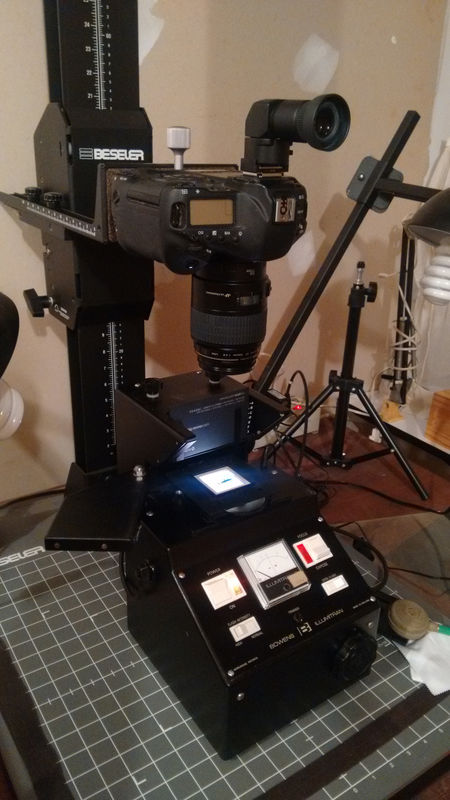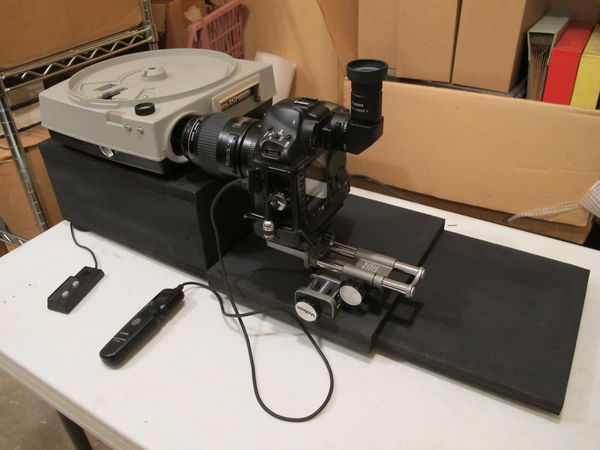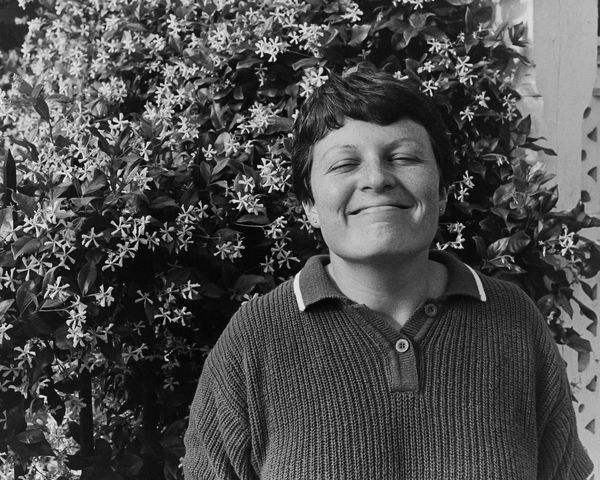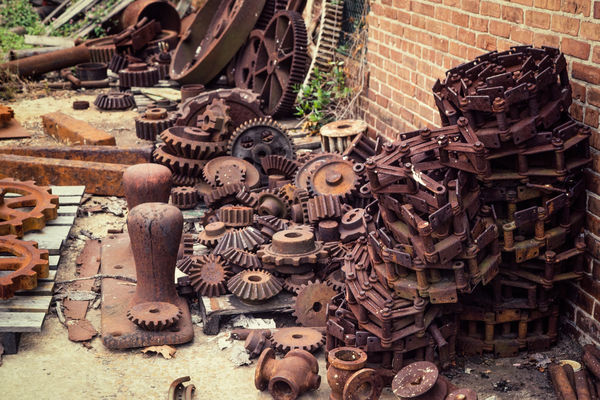Slide/negative scanners
Apr 4, 2018 10:07:59 #
OK, I had 2500 negatives I wanted to check out. I was able to borrow a light box and narrow it down to about a 1/4 of my negatives. I looked at the scanners available, some were very expensive, but I had to try it out and a local store (Fry's Electronics) had a Wolverine and at a discount ($140). This provided acceptable shots of high definition on initial use. You do need to tune the unit as they came out with a blue hue, but this is adjustable. I did some blow-ups of people and not bad - for use in a slide show. The new unit had a lot of dust spots, but I haven't tried their included cleaner tool to see how effective it is. For $140 it is acceptable, but spend some time with it.
Apr 4, 2018 10:11:57 #
Getting ready to send about 500 slides to Scan Cafe. Cost to be: $165.
Apr 4, 2018 10:23:15 #
I've been playing with different ways to "scan" old slides using my digital camera and macro lens from adapting a slide projector, to using a Logan A-7A slim edge light pad and mask under a copy stand to experimenting with an old Illumitrans slide duplicator that I picked up off ebay for $50. The Logan light pad worked really well but the Illumitrans is showing the best results. Its very quick and once you figure out the camera settings I'm getting some really good results.


Apr 4, 2018 10:26:36 #
I have a Plustek Opticfilm 8200 film scanner that I am very happy with. I use it with Vue Scan software which does a very good job of taking film negatives and transferring them to a digital format. Downsides are that scanning can be slow and labor intensive. The scanner has a slide holder that takes about four negatives that can be scanned one at a time. It may take several attempts to get a good scan. So if you have thousands of negatives, it will take too long to convert. I only scanned dozens of negatives and was happy with the result. I also scanned slides from the 1950s that turned out very well.
Apr 4, 2018 10:36:58 #
Dale40203 wrote:
I was expecting to see something of the grain in the negative since you were responding to a question regarding film scanning, and you specifically refer to details in the original film.
Here are two that should show the grain. The first was Ilford FP4. The second is Kodachrome 64. The slide was not terribly sharp. I remember taking this in late afternoon, near dusk, about 1/15 second, hand-held, wide open, using a 55mm f/3.5 Micro Nikkor on my FTn. I THINK I used an 81A warming filter with it.
Apr 4, 2018 10:42:35 #
JackW wrote:
I've been playing with different ways to "scan" old slides using my digital camera and macro lens from adapting a slide projector, to using a Logan A-7A slim edge light pad and mask under a copy stand to experimenting with an old Illumitrans slide duplicator that I picked up off ebay for $50. The Logan light pad worked really well but the Illumitrans is showing the best results. Its very quick and once you figure out the camera settings I'm getting some really good results.
YES! The Illumitran is a phenomenal device. I had one, back in the 1980s. I ran the multi-image/AV production department for my yearbook/school portrait company back then. We copied thousands and thousands of slides on that thing. We eventually bought a Beseler 4x5 color head, custom-inverted, with an attached "slide compound" — a device that could move slides in .001" increments for precise multiple exposure compositions. I still have the Nikon F3 with pin-registered back and precision viewfinder composition reticle that went along with it. I WISH I had either the Illumitran or the color head with compound.
Apr 4, 2018 10:55:53 #
has anyone used the OPTEKA slide scanner? Some one gave it to me. I wont be able to try out for a couple of months.
Apr 4, 2018 11:02:33 #
I own a Pacific Image Prime Film XA Slide & Negative Scanner coupled VUESCAN software. Below is a recent review I wrote on the Prime Film scanner I use it for negatives only. I am amazed at the results Very close to par with the original prints (poster sized) I made 18 years ago. For slides I use the Pacific Image Power Slide 5000 with mixed near comparable results (varied with condition of the slide). I bought from B&H
I have just finished scanning 1300 (18 years old) 35mm color negatives and thought I’d share some lessons learned. I am using VUESCAN software. The results are excellent. I am using 10000dpi with 3 scans per image. The image size is approx. 90MB for jpg and 100MB for RAW. I scan 4 images at a time which takes about one hour. This size image can be viewed on higher end SONY 4K TVS. They must be reduced to view on Samsung 4K TVs. I have several strips of 3 and several strips of two images. Strips of three work fine, but the scanner won’t feed the strips of two. There was a mention the scanner scratches film. If the film is cupped (not flat) if doesn’t feed properly and appears to scratch the film. The software does a great job of repairing these scratches. I have it set at medium dust removal. The age of the film also shows some film flaking which the software does a great job of hiding. It’s worth mentioning I am using an i7 Intel chip on a PC with 24 GB RAM and a Quadro Pro 5000 color card. Over all I’m amazed how well the image comes out. Hope this review helps.
I have just finished scanning 1300 (18 years old) 35mm color negatives and thought I’d share some lessons learned. I am using VUESCAN software. The results are excellent. I am using 10000dpi with 3 scans per image. The image size is approx. 90MB for jpg and 100MB for RAW. I scan 4 images at a time which takes about one hour. This size image can be viewed on higher end SONY 4K TVS. They must be reduced to view on Samsung 4K TVs. I have several strips of 3 and several strips of two images. Strips of three work fine, but the scanner won’t feed the strips of two. There was a mention the scanner scratches film. If the film is cupped (not flat) if doesn’t feed properly and appears to scratch the film. The software does a great job of repairing these scratches. I have it set at medium dust removal. The age of the film also shows some film flaking which the software does a great job of hiding. It’s worth mentioning I am using an i7 Intel chip on a PC with 24 GB RAM and a Quadro Pro 5000 color card. Over all I’m amazed how well the image comes out. Hope this review helps.
Apr 4, 2018 11:45:28 #
Ron Dial
Loc: Cuenca, Ecuador
I own two dedicated film scanners, both Minolta (before they were purchased by Sony). They still do great work. It is all about the software that runs the scanner. i usually scan at the highest resolution possible and run the dust removal tool. If you do this, you should research how the dust removal tool works. I still shoot film and love the scanners. They are clearly better than flat bed scanners, unless you are doing wet scans (similar to drum scanners). If you are going to get into this, encourage you to do a lot of research or take some classes on scanning. Scan to TIFF's and do post work in Photoshop, and remember a scanned image will need a LITTLE bit of sharpening.
Apr 4, 2018 11:51:21 #
Ron Dial wrote:
I own two dedicated film scanners, both Minolta (b... (show quote)
Ron, would your scanner be the Konica Minolta DiMage Scan Dual IV? I own one but am having software problems with Win 10.
Apr 4, 2018 12:54:40 #
My problem has been in finding a scanner that can handle the 127 film format slides (1 5/8" x 1 5/8"). They all seem to only handle 35mm or smaller formats.
Apr 4, 2018 14:37:17 #
Mr Bill 2011
Loc: southern Indiana
Kiriakos wrote:
My question is addressed to those owing and using scanners type Digitnow, Jumbl, Wolverine etc and not the ones owing flatbed full scanners the likes of Epson, Canon etc.
Can you please comment about the quality of the scanned images and if you are happy with them. Try not comparing to flatbeds.
Thank you
Can you please comment about the quality of the scanned images and if you are happy with them. Try not comparing to flatbeds.
Thank you
I have a Wolverine scanner that I use occasionally for a "quick & dirty" survey of older 35mm B&W negs from the 1960s and 70s. I find it's really not much good for scanning color slides. I won't compare it to my Epson flatbed scanner because it really doesn't compare to the flatbed scanner.
Apr 5, 2018 20:46:05 #
Ron Dial
Loc: Cuenca, Ecuador
Yes. I had to change software to VueScan. And it runs on Firewire connection, but it still works well.
If you are using 120 film, think about the Epson 750 scanner and doing "wet scans". These scans use Kami scanning fluid, (available from Aztec), and mimic a Drum Scan. Wet scans will fill scratches and eliminate dust. Kami makes scanning fluid and cleaning fluid for film. Basically, you build up a "dam" on the glass with a special tape, fill it with fluid and them immerse the negative or transparency in the fluid, cover it with special optical glass (available from most glass shops by special order) and scan it. Use maximum resolution in a TIFF format. I have done this with 100 year old silver nitrate cellulose negative with stunning results.
Consider Silver Fast software for your flatbed scans.
If you are using 120 film, think about the Epson 750 scanner and doing "wet scans". These scans use Kami scanning fluid, (available from Aztec), and mimic a Drum Scan. Wet scans will fill scratches and eliminate dust. Kami makes scanning fluid and cleaning fluid for film. Basically, you build up a "dam" on the glass with a special tape, fill it with fluid and them immerse the negative or transparency in the fluid, cover it with special optical glass (available from most glass shops by special order) and scan it. Use maximum resolution in a TIFF format. I have done this with 100 year old silver nitrate cellulose negative with stunning results.
Consider Silver Fast software for your flatbed scans.
Apr 5, 2018 20:52:06 #
Ron Dial
Loc: Cuenca, Ecuador
If you are having trouble getting it to run in Windows 10, go into Windows File Explorer, go to the exe file you are using, right click and open "properties" and Compatibility, and designate it to be run under an older version of Windows like Vista or Windows 7.
Apr 5, 2018 20:57:02 #
Ron Dial wrote:
Yes. I had to change software to VueScan. And it... (show quote)
Ron, I'm assuming your post was in response to mine mentioning the Minolta scanners. If so, thanks. I'll have to look into the VueScan software.
If you want to reply, then register here. Registration is free and your account is created instantly, so you can post right away.





